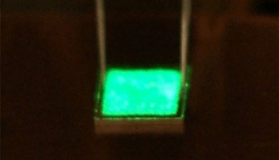Novel green LED built on silicon substrate
on

US semiconductor technology company RoseStreet Labs (RSL) has announced what it claims to be the world's first long wavelength LED device built on a low-cost silicon wafer substrate. According to RSL, LEDs operating at green or longer wavelengths would fill a demand gap in the rapidly growing commercial and industrial markets for lighting and illumination.
RSL's device compliments its proprietary thin-film InGaN-on-silicon technology for high efficiency photovoltaic applications and power devices. These longer wavelength devices are fabricated using commercial scale deposition tools at RSL's Nitride Research Center in Phoenix, Arizona. Silicon substrates have a substantial cost advantage over the more traditional sapphire or silicon carbide substrates typically utilized in LED fabrication, the company claims.
Efficient long wavelength LEDs are regarded as essential milestones on the roadmap for solid state lighting, LED backlighting and next generation display technology. Green or longer wavelength nitride-based LEDs are much more difficult to fabricate than UV and blue LEDs, due to lower quantum efficiencies, and have remained a tough challenge for the LED industry.
RSL scientists have also demonstrated the initial capability of this technology for tuning to cover the multi-colour and white light spectrums. The new device holds great promise due to its potential for high intensity, low energy consumption, and a path to very low commercial cost. RSL believes this technology can be commercialised in two to three years with migration to 200 mm silicon substrates.
Image: RoseStreet Labs


Discussion (0 comments)